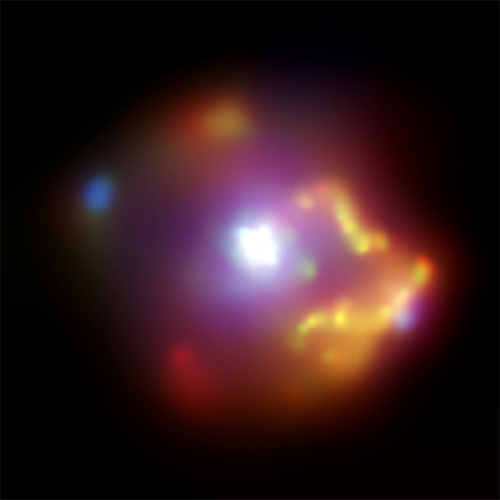NASA shared a mesmerizing photo of the remains of a star that exploded violently and created a supernova event. Based on the observations by the agency, the energy released by the stellar explosion was equivalent to 30,000 suns.
The supernova remnant featured in the photo shared by NASA is called SNR 0540-69.3. It was photographed by the agency's Chandra X-ray Observatory.
Creating A Supernova Event

As noted by NASA, SNR 0540-69.3 lies about 160,000 light-years from Earth and is located within Milky Way's galactic neighbour, the Large Magellanic Cloud. According to the agency, the supernova remnant was formed after a star imploded, or collapsed under the weight of its own gravity.
This is a natural phenomenon that usually occurs when a star reaches the end of its life cycle. As it collapsed, the implosion packed the stellar material into an extremely dense neutron star that's about 10 miles wide. It then triggered a powerful explosion that sent powerful shock waves travelling across space at speeds of over five million miles per hour.
SNR 0540-69.3's Neutron Star
According to NASA, SNR 0540-69.3's neutron star can be spotted in the photo as the bright white object in the middle. Also known as a pulsar, this neutron star is spinning rapidly and sits at the centre of a massive cloud composed of hot gas.
"The central intense white blaze of high-energy particles about three light-years across was created by a rapidly rotating neutron star or pulsar," NASA stated. "Surrounding the white blaze is a shell of hot gas 40 light-years in diameter that marks the location of the supernova shock wave."
Comparing SNR 0540-69.3 With The Crab Nebula
NASA noted that the explosion produced by SNR 0540-69.3 is reminiscent of the blast produced by the Crab Nebula, a supernova remnant that's only about 6,000 light-years from Earth. According to the agency, both the SNR 0540-69.3 and the Crab Nebula have extremely active pulsars that are emitting high levels of X-ray radiation.
These two stellar structures are also surrounded by magnetized clouds of high-energy particles. The main difference between the two, however, is that the surroundings of SNR 0540-69.3 are very different from those of the Crab Nebula.
"However, the extensive outer shell of 50 million degree Celsius gas in SNR 0540-69.3 has no counterpart in the Crab Nebula," NASA explained. "This difference is thought to be due to environmental factors. The massive star that exploded to create SNR 0540-69.3 was evidently in a region where there was an appreciable amount of gas."









